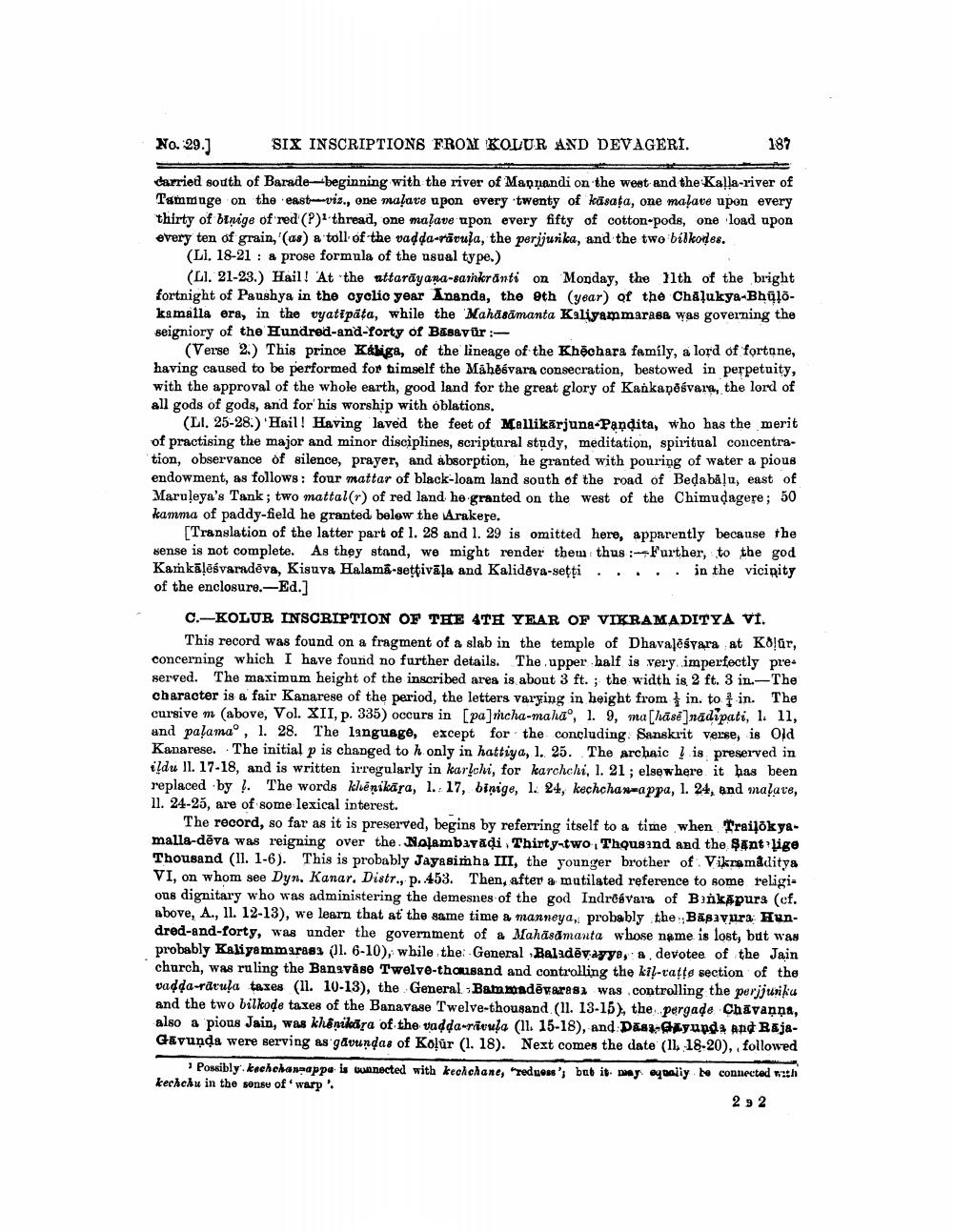________________
No. 29.)
SIX INSCRIPTIONS FROM KOLUR AND DEVAGERI.
187
carried south of Barade--beginning with the river of Mannandi on the west and the Kalla-river of Tammuge on the east-vis., one malate upon every twenty of kusafa, one mafavo upon every thirty of binige of red (?) thread, one malave upon every fifty of cotton-pods, one load upon every ten of grain,'(as) a toll of the vadda-rāvula, the perjjurika, and the two bídkodes.
(LI. 18-21 : a prose formula of the usual type.)
(LI. 21-23.) Hail! At the uttarāyana-samkrānti on Monday, the 11th of the bright fortnight of Paushya in the cyclio year Ananda, the oth (year) of the Chalukya-Bhulokamalla era, in the vyatipata, while the Mahāsāmanta Kaliyammarasa was governing the seigniory of the Hundred-and-Torty of Baseyür --
(Verse 2) This prince Kákiga, of the lineage of the Khechara famíly, a lord of fortane, having caused to be performed for himself the Maheśvara consecration, bestowed in perpetuity, with the approval of the whole earth, good land for the great glory of Kankapěśvare, the lord of all gods of gods, and for his worship with oblations,
(LI. 25-28.) 'Hail! Having laved the feet of Mallikarjuna-Pandita, who has the merit of practising the major and minor disciplines, scriptural study, meditation, spiritual concentration, observance of silence, prayer, and absorption, he granted with pouring of water a pious endowment, as follows: four mattar of black-loam land south of the road of Bedabāļu, east of Maruleya's Tank; two mattal(r) of red land he granted on the west of the Chimudagere; 50 kamma of paddy-field he granted below the Arakere.
[Translation of the latter part of l. 28 and 1. 29 is omitted here, apparently because the sense is not complete. As they stand, we might render them thus :-Further, to the god Kamkāļēsvaradeva, Kisuva Halama-gettivāla and Kalideva-setti....in the vicinity of the enclosure.--Ed.]
C.-KOLUR INSCRIPTION OF THE 4TH YEAR OF VIKRAMADITYA VI.
This record was found on a fragment of a slab in the temple of Dhavalesvara at Kdür, concerning which I have found no further details. The upper half is very imperfectly preserved. The maximum height of the inscribed area is about 3 ft.; the width is 2 ft. 3 in.-The character is a fair Kanarese of the period, the letters varying in height from in. to fin. The cursive m (above, Vol. XII, p. 335) occurs in [pa]rcha-maha°, 1. 9, ma[hase]nadipati, l. 11, and palama°, 1. 28. The language, except for the concluding Sanskrit verse, is Old Kanarese. The initial p is changed to h only in hattiya, 1. 25. The archaic ! is preserved in ildu 11. 17-18, and is written irregularly in kar!chi, for karchchi, 1.21 ; elsewhere it has been replaced by l. The words kluénikāra, 1.: 17, binige, 1. 24, kechchan-appa, 1. 24, and malate, 11. 24-25, are of some lexical interest.
The record, so far as it is preserved, begins by referring itself to a time when Trailokyamalla-dēva was reigning over the. Nalambayadi Thirty-two Thousand and the $untlige Thousand (11. 1-6). This is probably Jayasimha III, the younger brother of Vikramaditya VI, on whom see Dyn, Kanar, Distr., p. 453. Then, after a mutilated reference to some religious dignitary who was administering the demesnes of the god Indrekvara of Binkapura (cf. above, A., 11. 12-13), we learn that at the same time a manneya, probably the Basavura Hundred-and-forty, was under the government of a Mahäsdmanta whose name is lost, but was probably Kaliyammarasu (Jl. 6-10), while the: - General Baladēvayye, a devotee of the Jain church, was ruling the Bangvåse Twelve-thousand and controlling the kil-tatte section of the vadda-rdruļa taxes (11. 10-13), the General - Bammadēvaras, was controlling the perjjuriku and the two bilkode taxes of the Banavase Twelve-thousand (11. 13-15), the pergade Chivanna, also a pious Jain, was kha nikära of the vadda-ricula (11. 15-18), and Dasa-Gayunda and RajaGāvunda were serving as gavundas of Kolur (1. 18). Next comes the date (11. 18-20), followed
Possibly knehohannappa is wonnected with kechchane, red goss's bab it may oynally to connected with kechchu in the sense of warp.
292




